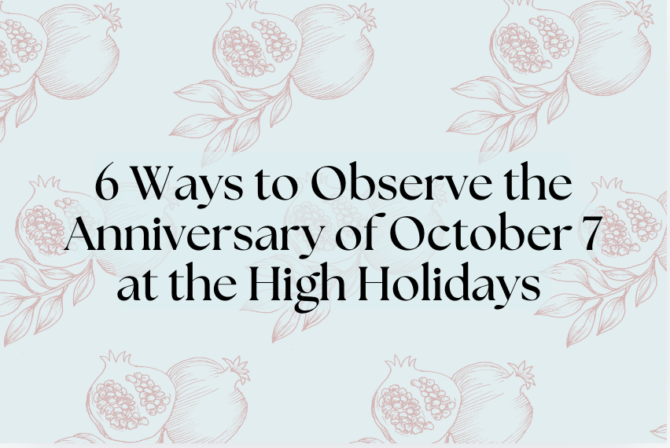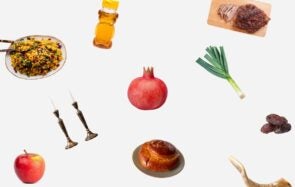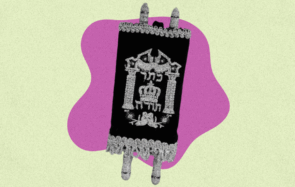In theory we would love to imagine and create new menus with fresh ingredients and ideas every week for Shabbat. But the fact is, it’s really not so easy! Shabbat comes around exactly once a week, never soon enough, but always sooner than expected. This versatile recipe for roast chicken is the sort of meal you can either throw together in a pinch or re-invent with every chicken you make.
This version is autumnal, but you can substitute in any vegetables and spices that you like. Zucchini or other summer squash, peppers, any winter squash, mushrooms, celery, carrots, even brussels sprouts are all good options depending on what you have on hand and what’s in season. And feel free to experiment with herbs, either dry or fresh. The only mandatory item is the chicken.
Chicken is often the center of the Shabbat dinner, and with good reason. For generations Jews have been making variations of this recipe to serve to their families on Friday nights. Both simple and adaptable, this recipe is a staple in Jewish kitchens around the world.
Do yourself a favor–always keep a chicken in the freezer. If your pantry, fridge, and cupboards are basically bare, you can still make a whole meal out of that chicken.
Many people prefer their chicken skinned and filleted. I prefer to use a whole chicken. This way, you can fill its cavity with herbs and other good stuff to enhance the flavor. Buying a whole chicken is also way more economical. If you want to lower your fat intake, take off the skin, by all means. But please, wait until the chook is cooked!
Ingredients
1 whole Roasted Chicken (Size; your preference. If this is basically your entire meal I would average about 1 lb per person.)
1 bunch fresh thyme, washed. Pull leaves off 5 stems.
2 lemons–1 quartered and 1 sliced thinly into rounds
1 head garlic–cloves separated, peeled, and bruised
3 potatoes with their skin on, coarsely chopped
1 sweet potato or yam with skin on, coarsely chopped
1 parsnip, peeled and coarsely chopped
1 leek washed well and sliced into rounds
1 head fennel, fronds included, sliced lengthways and chopped
Olive oil
Kosher salt
Freshly ground pepper
Splash of dry white wine (about ½ cup)
Sumac or paprika
Directions
Preheat oven to 350 F or 180 C.
Find the right sized roasting pan. This mostly depends on the amount of vegetables you want to use. In this recipe I have included a lot, so if you stick to my general list, you will need a pretty large roasting pan. It doesn’t have to be very deep though. Two inches is probably enough, but the deeper your pan, the safer you’ll be from oven spills.
Rinse the chicken under cool tap water. With a paring knife in hand, give the chicken a “once over” and pluck any larger feathers. (Don’t worry about the very small ones.)
Stuff the quartered lemon, about half the bunch of thyme, and half of the garlic cloves inside the cavity of the chicken.
Place the chicken into the center of the pan, legs and breast down. Throw on the separated thyme leaves and chopped fennel fronds. Sprinkle on the salt and pepper. Drizzle the olive oil. (If this seems too scary you can relax yourself by mixing all those ingredients first and making a little rubbing mixture.)
Then, rub that chicken all over. Dig into every crevice, fold, and crease. Herbs everywhere, please!
Toss all the vegetables, the lemon slices, and the leftover garlic cloves with some salt, olive oil, and 4 or 5 sprigs of the thyme. You can also use the naked sprigs here (if you haven’t already tossed them). Place the vegetable mixture around the chicken in a single layer. Press a couple of the lemon slices against the chicken. Sprinkle some sumac or paprika over the chicken’s skin.
Place uncovered in your hot oven for an hour. After about 30 minutes take out the tray, move around the vegetables and pour the wine over the chicken.
It’s easy to know when the veggies are done, but here’s how you test if your chook is cooked: If you have a meat thermometer, insert it into the fattiest part of the thigh, 180 F is certainly done. If you don’t have a meat thermometer, insert a fork into the thigh. It should go in with ease and the juices should run clear. If you’re really not sure, you can always cut somewhere in the thigh–it’s okay if the flesh nearest to the bones is still a little pink, it’s more about the texture–it shouldn’t feel rubbery anymore. But every oven is different so for the first time, keep an eye out and use your nose because before you know it, your home will be filled with the delicious aroma of a freshly roasted chicken.







